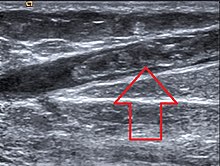Superficial vein thrombosis
Appearance

Superficial vein thrombosis (SVT) is a type of venous thrombosis, or a blood clot in a vein, which forms in a superficial vein near the surface of the body. Usually there is an inflammatory reaction around the vein which presents as a painful induration with erythema. SVT has a limited clinical significance (in terms of morbidity and mortality) when compared to a deep vein thrombosis (DVT), which occurs deeper in the body, at the deep venous system level. If the blood clot is too near from the sapheno-femural junction there is a bigger risk of pulmonary embolism.[1][2][3]
See also
This section is empty. You can help by adding to it. (May 2013) |
References
- ^ Di Nisio M, Wichers IM, Middeldorp S (2012). "Treatment for superficial thrombophlebitis of the leg". Cochrane Database Syst Rev. 3: CD004982. doi:10.1002/14651858.CD004982.pub4. PMID 22419302.
{{cite journal}}: CS1 maint: multiple names: authors list (link) - ^ Streiff MB, Bockenstedt PL, Cataland SR, et al. (2011). "Venous thromboembolic disease". J Natl Compr Canc Netw. 9 (7): 714–77. PMC 3551573. PMID 21715723.
- ^ Kitchens CS (2011). "How I treat superficial venous thrombosis". Blood. 117 (1): 39–44. doi:10.1182/blood-2010-05-286690. PMID 20980677.
